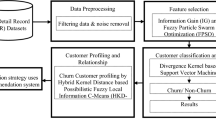Abstract
Customer churn prediction is one of the areas in Customer Relationship Management that differentiates loyal customers from factors that have a negative impact on business growth. Hence, various machine learning-based methods have been developed by researchers to accurately predict customer churn. However, high dimensionality and low prediction accuracy are problems in identifying averse customers. This paper presents a new system called PCA-PSO-K Means algorithm, which combines three algorithms: principal component analysis (PCA) for data set feature reduction, K Means algorithm for classification, and particle swarm optimization (PSO) algorithm to optimize K Means in providing initial centroids. The experimental results in the data set of one of the fixed internet providers in Isfahan Province show the improvement of the accuracy of customer churn prediction. The proposed system has an accuracy of 99.77%, a sensitivity of 75%, a specificity of 99.81% and a correlation coefficient of 0.443 ± 0.271. Found.









Similar content being viewed by others
Change history
18 March 2023
Affiliation 2 is updated from “Department of Computer Engineering, Najafabad Branch, Islamic Azad University, Najafabad, Iran” to “Faculty of Computer Engineering, Najafabad Branch, Islamic Azad University, Najafabad,Iran”.
16 January 2023
A Correction to this paper has been published: https://doi.org/10.1007/s11227-022-05015-z
31 March 2023
A Correction to this paper has been published: https://doi.org/10.1007/s11227-023-05204-4
References
Aziz AA, Ismail NH, Ahmad F (2013) Mining students’ academic performance. J Theor Appl Inform Technol 53(3):485–495
Gupta S, Lehmann DR, Stuart JA (2004) Valuing customers. J Mark Res 41(1):7–18
Ruholla Jafari-Marandi, Joshua Denton, Adnan Idris, Brian K. Smith, Abbas Keramati (2020) Optimum profit-driven churn decision making: innovative artificial neural networks in telecom industry. Springer-Verlag London Ltd., part of Springer Nature, Cham
Verbeke W, Dejaeger K, Martens D, Hur J, Baesens B (2012) New insights into churn prediction in the telecommunication sector: a profit driven data mining approach. Eur J Oper Res 218(1):211–229. https://doi.org/10.1016/j.ejor.2011.09.031
Alkhayrat M, Aljnidi M, Aljoumaa K (2020) A comparative dimensionality reduction study in telecom customer segmentation using deep learning and PCA. J Big Data. https://doi.org/10.1186/s40537-020-0286-0
García DL, Nebot A, Vellido A (2017) Intelligent data analysis approaches to churn as a business problem: a survey. Knowl Inf Syst 51(3):719–774
Pritesh Vora, Bhavesh Oza (2013) A survey on K-mean clustering and particle swarm optimization. Int J Sci Modern Eng (IJISME) 1(3). ISSN: 2319-6386.
Garvishkumar K Patel, Vipul K. Dabhi, Harshadkumar B. Prajapati (2017) Clustering using a combination of particle swarm optimization and K Means. J Intell Syst 26(3):457–469
Komarasamy G, Amitabh Wahi (2011) Improving the cluster performance by combining pso and K means algorithm. https://doi.org/10.21917/ijsc.2011.0032
Radhwani AMNA, Algamal ZY (2021) Improving K Means clustering based on firefly algorithm. J Phys Conference Ser. https://doi.org/10.1088/1742-6596/1897/1/012004
Buchori A, Prasetyowati D, Wijayanto (2020) Design of the magic book math media based on augmented reality. Test Engineering & Management. http://www.testmagzine.biz/index.php/testmagzine/issue/view/7
Chapman P, Clinton J, Kerber R, Khabaza T, Reinartz T, Shearer CEA (2000) CRISP-DM 1.0: Step-by-Step Data Mining Guide
Pratiwi H, Windarto AP, Susliansyah S, Aria RR, Susilowati S, Rahayu LK, Fitriani Y, Merdekawati A, Rahadjeng IR (2020) Sigmoid activation function in selecting the best model of artificial neural networks. J Phys Conf Ser. http://iopscience.iop.org/article/10.1088/1742-6596/1471/1/012010
Sudipa IGI, Astria C, Irnanda KF, Perdana A (2020) Application of MCDM using PROMETHEE II Technique in the Case of Social Media Selection for Online Businesses. Application of MCDM using PROMETHEE II Technique in the Case of Social Media Selection for Online Businesses
Acknowledgements
The authors thank the data provider for their extensive support.
Author information
Authors and Affiliations
Corresponding author
Additional information
Publisher's Note
Springer Nature remains neutral with regard to jurisdictional claims in published maps and institutional affiliations.
The original online version of this article was revised: In this article the affiliation ‘Department of Management, Najafabad Branch, Islamic Azad University, Najafabad, Iran’ for Naser Khani was missing.
Rights and permissions
Springer Nature or its licensor (e.g. a society or other partner) holds exclusive rights to this article under a publishing agreement with the author(s) or other rightsholder(s); author self-archiving of the accepted manuscript version of this article is solely governed by the terms of such publishing agreement and applicable law.
About this article
Cite this article
Sadeghi, M., Dehkordi, M.N., Barekatain, B. et al. Improve customer churn prediction through the proposed PCA-PSO-K means algorithm in the communication industry. J Supercomput 79, 6871–6888 (2023). https://doi.org/10.1007/s11227-022-04907-4
Accepted:
Published:
Issue Date:
DOI: https://doi.org/10.1007/s11227-022-04907-4




